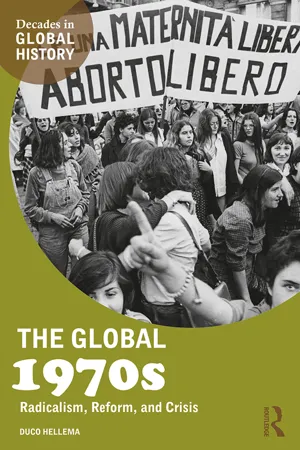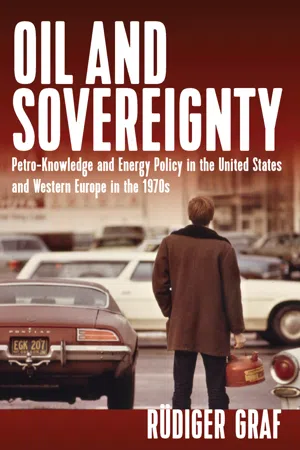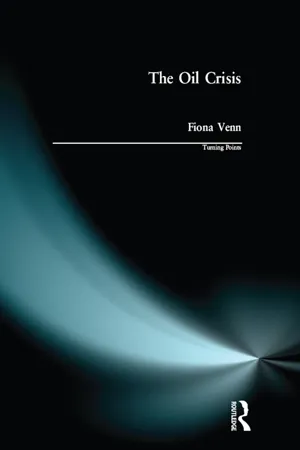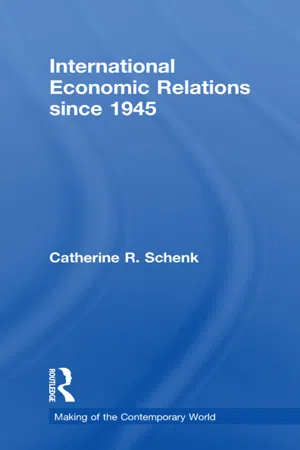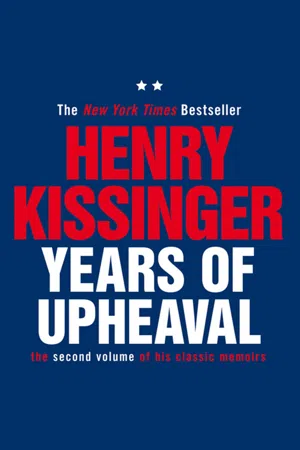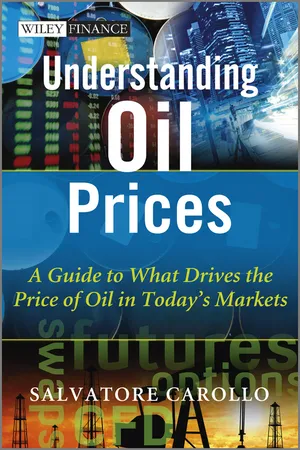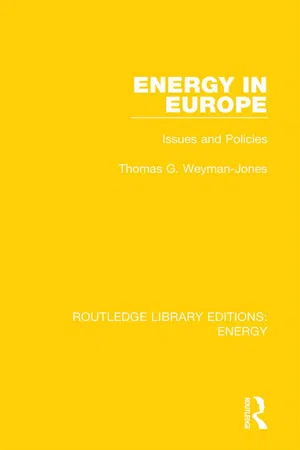Economics
Oil Crisis 1973
The 1973 oil crisis was a major event in which the members of the Organization of Arab Petroleum Exporting Countries (OAPEC) imposed an oil embargo on the United States and other countries that supported Israel in the Yom Kippur War. This led to a significant increase in oil prices and had a profound impact on the global economy, causing widespread inflation and energy shortages.
Written by Perlego with AI-assistance
Related key terms
9 Key excerpts on "Oil Crisis 1973"
- eBook - ePub
The Global 1970s
Radicalism, Reform, and Crisis
- Duco Hellema(Author)
- 2018(Publication Date)
- Routledge(Publisher)
6Crisis in the World Economy From the mid- to the late 1970sBy the mid-1970s, economic prospects were rapidly deteriorating everywhere in the world, the result of the oil crisis that broke out in the wake of the 1973 October War. Growth declined, inflation increased, and unemployment began to rise. As we have seen in previous chapters, the oil crisis and the economic recession of the mid-1970s affected the political atmosphere in large parts of the Western world. Budget cuts and austerity measures became inevitable, while reform plans had to deal with increasing financial problems. The oil crisis had a similar or even worse impact in other parts of the world, not least in the developing countries. In this chapter, we pay more systematic attention to the origins and the consequences of this mid-1970s worldwide economic recession. It was in many ways a truly global phenomenon, and as several commentators pointed out at the time, an example of increasing economic interdependence, viz. globalization.The oil crisis, its global impact, and its economic and political consequences are often presented as the start of a new era. Some authors even suggest that the seventies (in this case the ‘short’ seventies), the period of crisis and malaise, in fact began in 1973, dividing the 1970s into a progressive first half (the culmination of the 1960s, as some historians argue), and a conservative or neoliberal latter period (the start in fact of the eighties). In other words, the oil crisis acted as a global ‘game changer’, by undermining hitherto accepted political and economic paradigms and forcing states and other political actors (parties, unions) to adapt to the new circumstances. Yet, such conclusions are too easy. The oil crisis was in many ways the result – or culmination – rather than the negation of developments of the preceding years. The decisions of the Arab oil-producing states were a product of the growing non-Western assertiveness we have discussed in Chapter 4 - eBook - ePub
Oil and Sovereignty
Petroknowledge and Energy Policy in the United States and Western Europe during the 1970s
- Rüdiger Graf(Author)
- 2018(Publication Date)
- Berghahn Books(Publisher)
10Many commentators linked the oil crisis to more general economic or political changes in the industrialized nations, but also to mental or discursive shifts. During the crisis, a growing number of observers expressed fears that the oil price hikes might trigger a global recession and threaten the survival of the affluent societies of Western Europe, the United States and Japan. It thus seemed obvious to trace real-world economic developments back to the oil crisis, or at least to link the two.11 For Chancellor Helmut Schmidt, ‘just a few aspects’ of the ‘economic world’ of 1975 were ‘comparable to [the world] of 1973’.12 Two years later, at the Körber Foundation’s Bergedorf Round Table, Guido Brunner stated with respect to energy that things would ‘never be as they were before 1973’.13 In retrospect, many now considered the years of the economic boom a golden age, which was apparently gone forever.14 Exactly the same assessment of the oil crisis was being articulated on its ten-year anniversary:In light of the passage of a decade, October 1973 appears as a virtual continental divide, separating a post-World War II generation of economic recovery, prosperity, and Western unity from an era of stagflation, lost confidence, and disarray. In a sense this date is arbitrary. . . . Nonetheless, in its scope and endurance as a source of division, the crisis that began in October 1973 marked a new and identifiable era.15Given the globe-spanning structure of the oil economy, key actors also understood the changes wrought by the oil crisis as global in nature. These changes placed national foreign policy within a new set of parameters, which were often regarded as constraints. Concurrently, the newly emerging – and booming – environmental movements argued that, quite apart from the ecological costs of growing energy consumption, the availability of energy resources would place tighter limits on policy in future. The steps taken by OPEC and OAPEC, they contended, had merely expedited this process. In 1976, the first issue of the Annual Review of Energy thus regarded their actions as ‘the beginning of an era when man first fully realized the magnitude of the energy-resource-environment problem . . . which took many years to develop [and] will also take many years to solve’.16 A similarly unambiguous pathos of crisis and decision emanated from Erhard Eppler’s Ende oder Wende [End or Turning Point]. This study saw the world standing at a ‘historical turning-point’, shifting away ‘from an age in which humanity overcame limits to one in which it has to determine limits, from an age of unlimited possibilities to one of possible limitations, from an age of partial affluence to one in which we recognize what is superfluous’.17 - eBook - ePub
- Fiona Venn(Author)
- 2016(Publication Date)
- Routledge(Publisher)
Chapter 3 , was both more even-handed in its dealings with the respective belligerents than was expected by the Israeli Prime Minister, Golda Meir, and was also a startling departure from normal practice in the ‘hands-on’ approach adopted by the Secretary of State, which entailed spending long periods of time out of the United States. By the end of 1973, the main part of the crisis was over, although peace in the Middle East was still precarious, and the consuming nations were reeling at the likely impact of a fourfold increase in the price of oil in only three months. OPEC and OAPEC had both contributed to the cause of that increase: OAPEC through its boycott, as opposed to the oil price decisions which remained entirely within OPEC’s jurisdiction. In the discussions on the appropriate price level for oil, particularly in the December 1973 OPEC meeting that agreed on a new official price of over 11 dollars per barrel, one of the leading hawks was the Shah of Iran, leader of a non-Arab state which at that time provided Israel with the majority of its oil needs. The country taking the lead in implementing the oil boycott, Saudi Arabia, pressed for moderation on price, and argued forcibly against setting an official price close to the highest spot market levels. However, this potent combination – a Middle Eastern crisis and a feeling on the part of the oil producers that a price rise was appropriate and overdue – also coincided in the second major oil crisis of the decade in 1978–9.The second oil crisis: 1979
The gloomy prognostications of many commentators in the immediate aftermath of 1973 proved to be erroneous.41 Although the cash price of petroleum remained high, the escalating rates of inflation in the industrialized world eroded its impact upon their economies, while increasing the prices of manufactured goods to the developing world (including the members of OPEC). While the position of oil companies in the international oil industry had been affected by the unilateral decision by OPEC to take total control of oil price and production levels, changes had already been in train before 1973, and in many respects the shift towards a more managerial and technical role reduced political pressures upon the companies, while doing little to affect their profit levels. By the end of the 1970s, therefore, there was a real sense within the industrialized West that the worst of the oil crisis had definitely passed. However, towards the end of the decade, the international atmosphere once again became one of crisis, and yet again events in the Middle East, coupled with the desire of the oil producers to secure an increase in the real price of their oil, were to produce a dramatic and rapid increase in oil prices, and catapult the energy crisis back on to the international agenda.As in 1973, a number of different factors contributed to the genesis of the crisis. Of these trends, perhaps the most striking initially was the escalation of tension within the Cold War. The early 1970s had witnessed a slackening of some Cold War tensions, encouraged by the Nixon Administration, which had made friendly overtures towards the Soviet Union and China and encouraged détente - eBook - ePub
- Catherine R. Schenk(Author)
- 2011(Publication Date)
- Routledge(Publisher)
With many governments freed from the constraints of the pegged exchange rate system in the early 1970s, faster growth became an easier policy target for the core industrialised countries. This expansionism was further encouraged by the rapid increase in the global money supply, largely the result of sustained US balance-of-payments deficits through the end of the 1960s and the beginning of 1970s. From March 1973 the US dollar became cheaper against European currencies as President Nixon allowed the exchange rate to sink. Surging demand in rapidly growing industrial economies for food and for raw materials for construction pushed up the revenues of many primary product-producing countries that still pegged their exchange rates to the US dollar. The combination of large surpluses and a depreciating currency led to strong inflationary pressure for many countries such as Malaysia, Australia and New Zealand. Other countries, such as India as well as parts of Africa and Asia, suffered from drought and poor harvests that inflated the price of food, further adding to inflation. In this volatile environment with fluctuating exchange rates, a commodity market boom and inflation, the first oil crisis struck global markets in the autumn of 1973.Although triggered by a political event, there were several economic bases of the 1973 oil crisis. First, international demand for oil is price inelastic, which is another way of saying that the demand for oil is not as responsive to changes in price as some other goods. This is partly because moving to substitutes such as coal or nuclear energy tends to be costly since entrenched technology makes it expensive to switch from one source of energy to another. In the 1960s, industry, automobiles, home heating and electricity had come to rely on relatively cheap oil as the main source of energy. Large price rises would tend to increase producer revenue rather than decrease demand dramatically – that is, international demand was not very sensitive to rises in price. Second, the supply of oil was fairly concentrated geographically in OPEC. Figure 4.1 - eBook - ePub
- Neil Cockett(Author)
- 2020(Publication Date)
- Informa Law from Routledge(Publisher)
The oil age which ended in 1973 was characterised by cheap and secure supplies from the Middle East, the domination of the world industry by the majors and a belief that this combination of factors would go on for ever. This explains the traumatic Western reactions to the events of 1973 and 1974, when the control of the international oil industry effectively passed into the hands of OPEC (the Organisation of Petroleum Exporting Countries), which henceforth determined prices and production in its own member countries. Later, of course, market forces weakened OPEC’s grip and it is ironic that, in part, the increased supply now challenging the organisation was developed on the back of relatively high prices, supported by OPEC’s voluntary production reductions and new technology, inspired by OPEC’s flooding of the market in the mid-1980s.Since the early 1970s, the oil world has been subjected to a series of further dramas. In 1979/80, prices rose again to shock a complacent world, as two Middle Eastern OPEC members, Iran and Iraq, joined in war. The former, of course, had recently removed the ruling regime, headed by the Shah, and imposed a theocracy, about which little was known initially.Eventually, the higher prices of the 1970s stimulated non-OPEC supply, encouraged additional production from other primary energy sources and curbed demand. Under the pressure of higher overall supplies of primary energy and, of course, of non-OPEC oil, crude oil prices started moving down gradually until Saudi Arabia, hitherto providing the safety net, by restricting its own output to intolerable levels, withdrew co-operation, causing prices to plunge by over half in a few weeks to levels not seen for over a decade. - eBook - ePub
Oil Shock
The 1973 Crisis and its Economic Legacy
- Elisabetta Bini, Giuliano Garavini, Federico Romero(Authors)
- 2016(Publication Date)
- I.B. Tauris(Publisher)
4Eight Squeezed Sisters: The Oil Majors and the Coming of the 1973 Oil CrisisFrancesco PetriniThis chapter investigates the role of the oil majors (the eight multinational corporations that controlled crude production in the Middle East) in the events leading up to the 1973 crisis.1 The quadrupling of oil prices in autumn 1973 was, in part, a consequence of the use of oil as a weapon in the Arab–Israeli conflict. However, much more than this, it was the outcome of a long-standing duel between the oil-exporting countries and the oil companies, whose ultimate stake was the control of the international oil market. To limit ourselves to the immediate causes, the overthrowing of the Libyan monarchy in a military coup in 1969 can be seen as the starting date of a triangular dialectic. This dialectic involved oil companies, producing countries and consuming countries, and resulted in the demise of the concessionary system and soaring oil prices.2 In this critical phase, the companies were directly negotiating with the countries that were part of the Organization of the Petroleum Exporting Countries (OPEC), while the consumer governments remained in the background, watching, with growing anxiety, a situation that was increasingly out of Western control.Our narrative concentrates on the crucial months between January 1970, when the new Libyan government demanded a revision of the concessionary terms, and February 1971, when a group of 13 companies and the Persian Gulf producer governments signed, in Tehran, an agreement on new posted prices (the reference prices for tax purposes). We attempt, in this chapter, to go a step further, relative to the existing literature, and to investigate these negotiations in the light of some of the available primary sources.Indeed, very few works have analysed in detail the events narrated here. Even less has been written from the companies’ point of view. Among the most useful is the report drawn up for the hearings on multinational corporations held by the US Senate in 1974 by Henry Schuler, executive of a US ‘independent’3 oil company, who had a direct role in the negotiations.4 - eBook - ePub
Years of Upheaval
The Second Volume of His Classic Memoirs
- Henry Kissinger(Author)
- 2011(Publication Date)
- Simon & Schuster UK(Publisher)
XIXThe Energy Crisis The Years of ComplacencyI RETURNED to Washington in exultation. But rare are the crises that lend themselves to dramatic revolutions. Usually change appears in the guise of the commonplace, not as a catharsis but as a series of technical decisions. So it was with the energy crisis, which now reclaimed us.It began dramatically enough in 1973, and altered irrevocably the world as it had grown up in the postwar period. The seemingly inexorable rise in prosperity was abruptly reversed. Simultaneously, inflation ran like a forest fire through the industrialized countries and recession left millions unemployed. The poorer countries without oil plunged into deeper depression and unredeemable debt, while the oil producers suddenly had more money than they could possibly spend. Their vast, mobile cash balances played havoc with currencies as they moved among capitals for reasons economic or political. Transcending even the economic revolution was the emergence of oil as a weapon of political blackmail. The industrial democracies saw imposed on them not only an economic upheaval but fundamental changes in their social cohesion and political life.But the remedy proved prolonged; the effects of these convulsions continue to this day. Our economic system has not yet recovered; the political and social consequences are still playing themselves out.How could a transformation of such a profound and far-reaching nature come so suddenly upon us? Much of it is clearer in retrospect, for the seeds and the signals of dramatic change were there. The oil revolution was of a pattern with many historical revolutions. They were inevitable but their inevitability is obvious only after the fact. It is almost impossible for historians to understand how in advance of some of history’s great revolutions it was often not even realized that a change was about to take place. Lulled by the illusion of permanence, the soon-to-be victims treated as fleeting aberrations warnings that posterity now sees as self-evident. And therefore dikes that could have been strengthened to hold back the flood were left unattended until they suddenly burst and the torrents engulfed those who had never suspected danger. - eBook - ePub
Understanding Oil Prices
A Guide to What Drives the Price of Oil in Today's Markets
- Salvatore Carollo(Author)
- 2011(Publication Date)
- Wiley(Publisher)
After several months of such practice, two parallel markets were actually created, one based on official prices and the other on spot prices. Thus, for the same type of crude there could be two prices, differing by as much as $10 per barrel. To remedy this situation, an extraordinary meeting was convened by OPEC, which resolved to reduce the official price of Arabian Light from $34 to $29 per barrel and to re-establish lower production quotas for its members. This decision was reached after furious discussions betweens the hawks (Iran at their head, who wanted to keep the price high) and the doves (headed by Saudi Arabia, who wanted to align with the real market).The three following years were marked by a continuous weakening of crude prices, due to a combination of factors. After the crisis of 1973 the first effects of energy diversification began to become apparent with:- The start-up of the new nuclear power stations, which began to cause a visible and progressive reduction in the consumption of fuel oil burned in the thermo-electric power stations, triggering a structural crisis in the refining system, particularly in Europe.
- An increase in the supplies of natural gas for electricity production as well as for domestic heating.
Refining capacity underwent a process of radical re-conversion and restructuring. The refineries found themselves at a crossroads: should they build cracking plants to transform fuel oil into gasoline and diesel fuel (thus improving refining margins), or shut down.The production of the non-OPEC nations, historically marginal, began to become relevant and competitive on the international market. In particular, production in the North Sea began to play a key role in the political and economic balance in the oil world. These were the years when the prime minister of the United Kingdom was Margaret Thatcher, who wanted to deal a powerful blow on the excessive power of the OPEC countries. Thatcher's government refused any form of dialogue or cooperation with the OPEC countries tending to regulate crude prices by adjusting production. Together with the government of the USA, whose President was then Ronald Reagan, Mrs Thatcher wanted to reach the objective of having a crude oil price that was the result of free market transactions and without any political control by the OPEC cartel. - eBook - ePub
Energy in Europe
Issues and Policies
- Thomas G. Weyman-Jones(Author)
- 2019(Publication Date)
- Routledge(Publisher)
Essentially two types of response to the oil price rise were possible. On the one hand many argued that this was only one more short-term demand panic in an otherwise long-term history of falling oil prices, and that OPEC would go the way of every other cartel in internal bickering and eventual break up. On the other hand there were those who felt that the oil price rise signalled the start of an energy shortage and that both permanent conservation and investment in high-cost alternatives would characterize the future.There were significant spillovers into other fuel markets and energy prices rose over the remainder of the decade, though not always in real terms. However from 1974 to 1978 oil prices remained stable, and the world’s preoccupation was with the macroeconomic responses to the oil shock.In 1978–9 short-term factors were again able to permit OPEC to push up prices abruptly. The fall of the Shah of Iran and a temporary loss of Iranian oil production coincided with a large rundown of oil stocks in Europe and rising spot prices. It took very little in the form of production cutbacks to stimulate another panic about oil shortage and although the International Energy Agency’s (IEA’s) emergency allocation scheme was now available, it was not brought into operation. The OPEC cartel was able to push through the second oil shock.THE CONSERVATION RESPONSE 1981–6
Energy conservation took off substantially as the cumulative effects of two price shocks and the policy-induced recession caused oil demand in particular to collapse. The glut of oil at prevailing prices became apparent, and for the first time OPEC was faced with maintaining prices through production cutbacks. This job was made more difficult because the Middle East members had completed their moves towards nationalization and none of the major or independent oil companies could be used to allocate production quotas instead of explicit compromises within OPEC. Indeed, by acting simply as buyers of crude oil the oil companies were now countervailing competitors rather than collaborators in OPEC’s control of world oil markets.
Learn about this page
Index pages curate the most relevant extracts from our library of academic textbooks. They’ve been created using an in-house natural language model (NLM), each adding context and meaning to key research topics.
